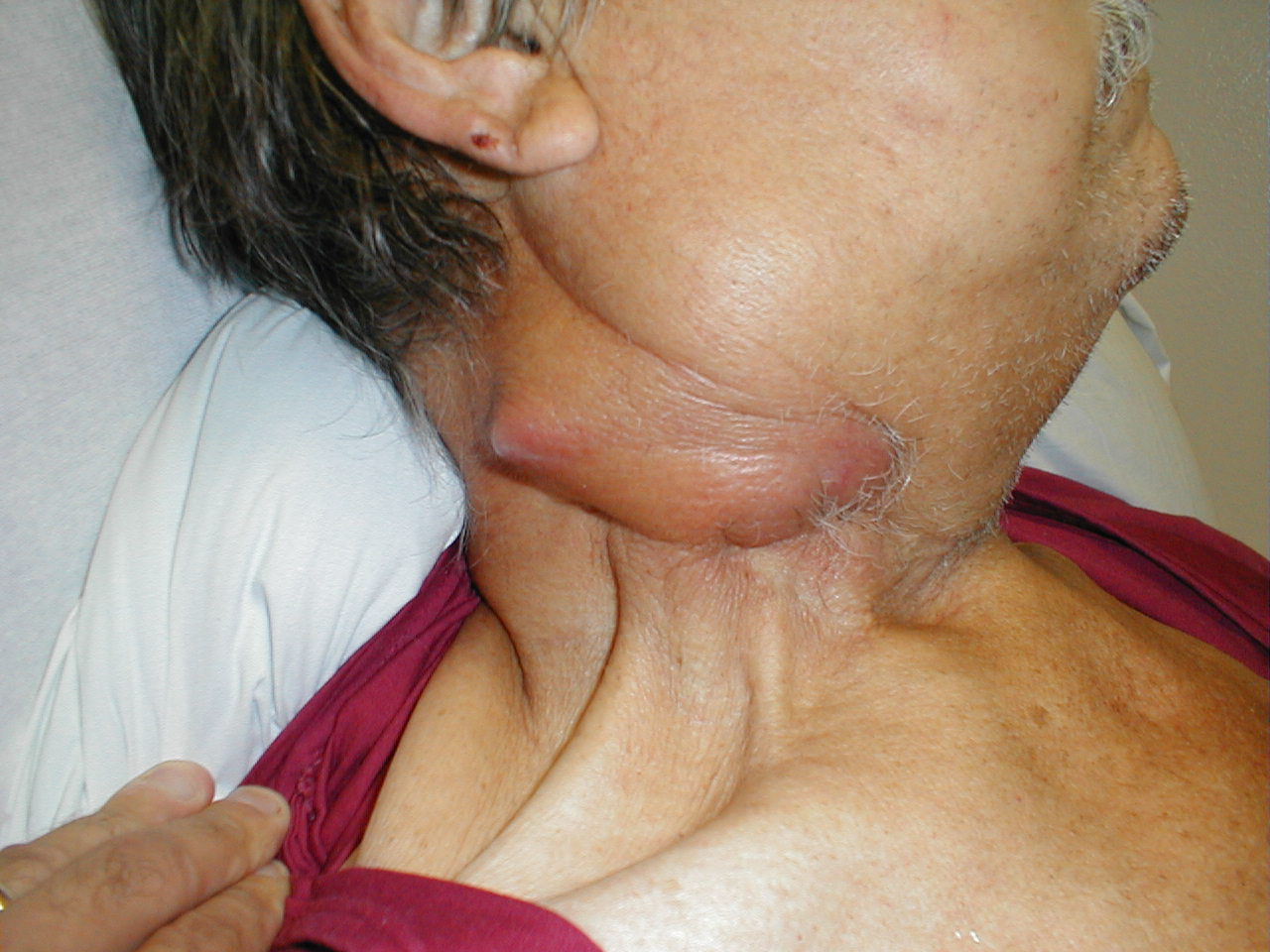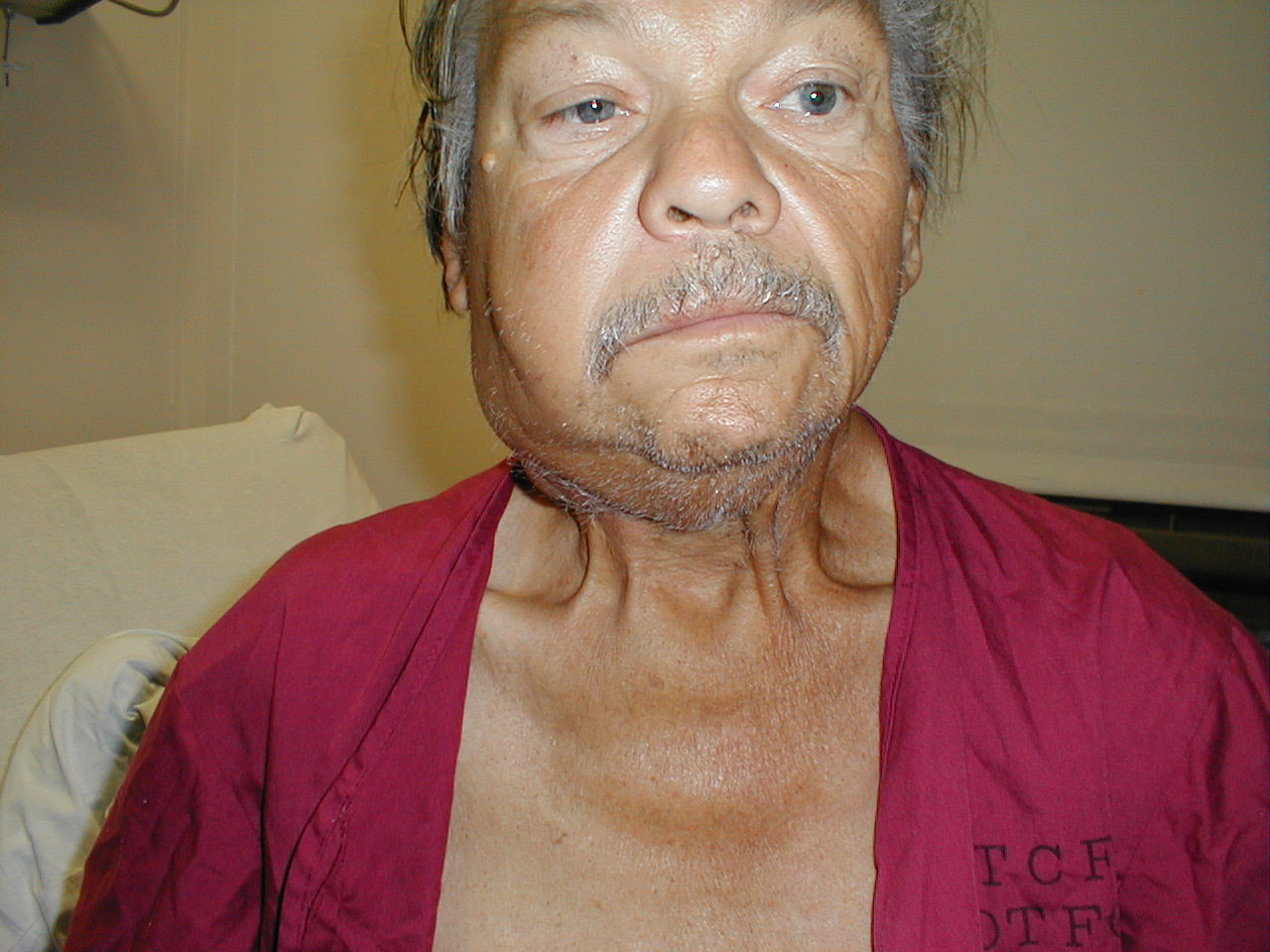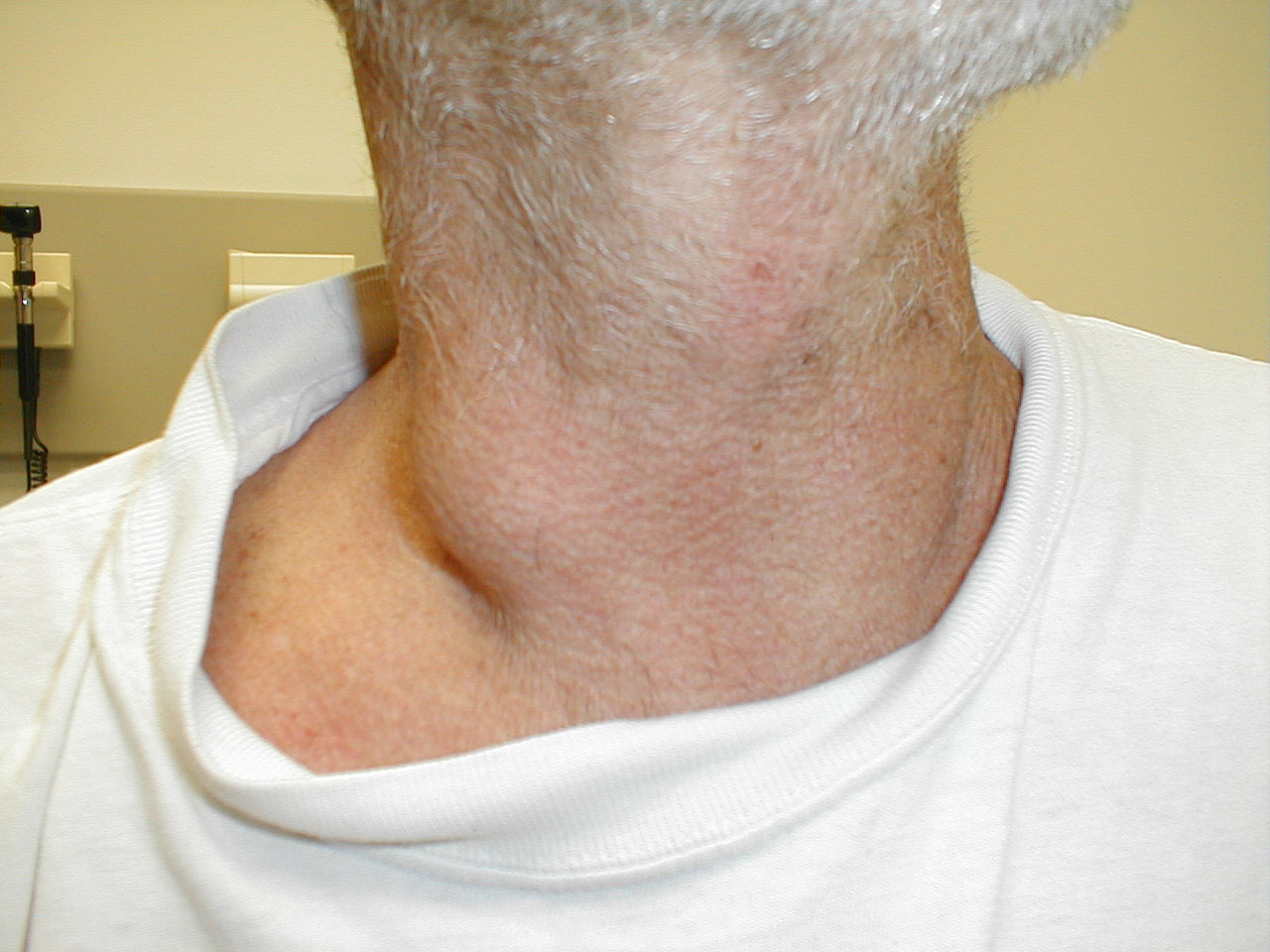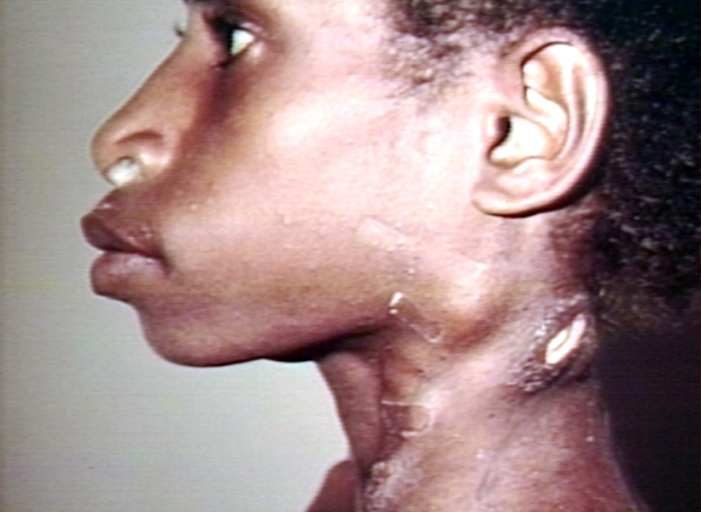Sandbox: Lymphadenopathy: Difference between revisions
| (38 intermediate revisions by the same user not shown) | |||
| Line 6: | Line 6: | ||
==Overview== | ==Overview== | ||
'''Lymphadenopathy''' (also known as "enlarged lymph nodes) refers to [[lymph nodes]] which are abnormal in size, number or consistency. Common causes of lymphadenopathy are [[infection]], [[autoimmune]] disease, or [[malignancy]].<ref name="!">{{cite journal|last=King|first=D|last2=Ramachandra|first2=J|last3=Yeomanson|first3=D|title=Lymphadenopathy in children: refer or reassure?|journal=Archives of Disease in Childhood: Education and Practice Edition|date=2 January 2014|pmid=24385291|doi=10.1136/archdischild-2013-304443|volume=99|pages=101–110}}</ref> Lymphadenopathy may be classified according to distribution into 2 groups: generalized lymphadenopathy and localized lymphadenopathy. The pathogenesis of lymphadenopathy is characterized by the inflammation of lymph nodes. This process is primarily due to an elevated rate of trafficking of [[lymphocytes]] into the node from the blood, exceeding the rate of outflow from the node. Lymph nodes may also be enlarged secondarily as a result of the activation and proliferation of antigen-specific T and [[B cells]] (clonal expansion). Lymphadenopathy is very common, the estimated incidence of lymphadenopathy among children in the United States ranges from 35%- 45%.<ref name="pmid24753638">{{cite journal |vauthors=Mohseni S, Shojaiefard A, Khorgami Z, Alinejad S, Ghorbani A, Ghafouri A |title=Peripheral lymphadenopathy: approach and diagnostic tools |journal=Iran J Med Sci |volume=39 |issue=2 Suppl |pages=158–70 |year=2014 |pmid=24753638 |pmc=3993046 |doi= |url=}}</ref> Patients of all age groups may develop lymphadenopathy. Lymphadenopathy is more commonly observed among children. Common complications of lymphadenopathy, may include: [[Abscess|abscess formation]], [[superior vena cava syndrome]], and [[intestinal obstruction]]. Diagnostic criteria for malignant lymphadenopathy, may include: node > 2 cm, node that is draining, hard, or fixed to underlying tissue, atypical location (e.g. supraclavicular node), associated risk factors (e.g. [[HIV AIDS|HIV]] or [[Tuberculosis|TB]]), fever and/or weight loss, and splenomegaly. On the other hand, diagnostic criteria for benign lymphadenopathy, may include: node < 1 cm, node that is mobile, soft-or tender, and is not fixed to underlying tissue, typical location (e.g. supraclavicular node), no associated risk factors, and palpable and painful enlargement. Laboratory findings consistent with the diagnosis of lymphadenopathy, may include: elevated lactate dehydrogenase (LDH), mild neutropenia, and [[leukocytosis]]. There is no treatment for lymphadenopathy; the mainstay of therapy is treating the underlying condition. | |||
==Classification== | ==Classification== | ||
*Lymphadenopathy may be classified according to distribution into 2 groups: | *Lymphadenopathy may be classified according to distribution into 2 groups:<ref name="pmid24753638">{{cite journal |vauthors=Mohseni S, Shojaiefard A, Khorgami Z, Alinejad S, Ghorbani A, Ghafouri A |title=Peripheral lymphadenopathy: approach and diagnostic tools |journal=Iran J Med Sci |volume=39 |issue=2 Suppl |pages=158–70 |year=2014 |pmid=24753638 |pmc=3993046 |doi= |url=}}</ref> | ||
:*Generalized lymphadenopathy | :*Generalized lymphadenopathy | ||
:*Localized lymphadenopathy | :*Localized lymphadenopathy | ||
==Pathophysiology== | ==Pathophysiology== | ||
*The pathogenesis of lymphadenopathy is characterized by | *The pathogenesis of lymphadenopathy is characterized by the inflammation of lymph nodes. This process is primarily due to an elevated rate of trafficking of lymphocytes into the node from the blood, exceeding the rate of outflow from the node.<ref name="pmid24753638">{{cite journal |vauthors=Mohseni S, Shojaiefard A, Khorgami Z, Alinejad S, Ghorbani A, Ghafouri A |title=Peripheral lymphadenopathy: approach and diagnostic tools |journal=Iran J Med Sci |volume=39 |issue=2 Suppl |pages=158–70 |year=2014 |pmid=24753638 |pmc=3993046 |doi= |url=}}</ref> | ||
*The inmune response between the antigen and lymphocyte that leads to cellular proliferation and enlargement of the lymph nodes. | |||
*Lymph nodes may also be enlarged secondarily as a result of the activation and proliferation of antigen-specific T and B cells (clonal expansion). | |||
*On gross pathology, characteristic findings of lymphadenopathy, include: | *On gross pathology, characteristic findings of lymphadenopathy, include: | ||
:*Enlarged lymph node | :*Enlarged lymph node | ||
:*Soft greasy yellow areas within capsule | :*Soft greasy yellow areas within capsule | ||
*On microscopic histopathological analysis, characteristic findings of lymphadenopathy will depend on the aetiology. | *On microscopic histopathological analysis, characteristic findings of lymphadenopathy will depend on the aetiology. | ||
*Common findings, include: | *Common findings, include:<ref name="pmid24753638">{{cite journal |vauthors=Mohseni S, Shojaiefard A, Khorgami Z, Alinejad S, Ghorbani A, Ghafouri A |title=Peripheral lymphadenopathy: approach and diagnostic tools |journal=Iran J Med Sci |volume=39 |issue=2 Suppl |pages=158–70 |year=2014 |pmid=24753638 |pmc=3993046 |doi= |url=}}</ref> | ||
'''Non-specific reactive follicular hyperplasia (NSRFH)''' | '''Non-specific reactive follicular hyperplasia (NSRFH)''' | ||
:*Large spaced cortical follicles | :*Large spaced cortical follicles | ||
| Line 46: | Line 47: | ||
==Causes== | ==Causes== | ||
*Common causes of lymphadenopathy, include: | *Common causes of lymphadenopathy, include:<ref name="pmid24753638">{{cite journal |vauthors=Mohseni S, Shojaiefard A, Khorgami Z, Alinejad S, Ghorbani A, Ghafouri A |title=Peripheral lymphadenopathy: approach and diagnostic tools |journal=Iran J Med Sci |volume=39 |issue=2 Suppl |pages=158–70 |year=2014 |pmid=24753638 |pmc=3993046 |doi= |url=}}</ref> | ||
:*'''Infections''' (acute suppurative) | :*'''Infections''' (acute suppurative) | ||
::*Fungal | ::*Fungal | ||
::*Mycobacterial | ::*Mycobacterial | ||
::*Viral | ::*Viral | ||
::*Protozoal (e.g. toxoplasma) | ::*Protozoal (e.g. [[Toxoplasmosis|toxoplasma]]) | ||
::*Bacterial (e.g. chlamydia, rickettsia, bartonella) | ::*Bacterial (e.g. [[chlamydia]], [[Rickettsia rickettsii infection|rickettsia]], [[bartonella]]) | ||
:*'''Reactive''' | :*'''Reactive''' | ||
::*Follicular hyperplasia | ::*Follicular hyperplasia | ||
| Line 65: | Line 66: | ||
==Epidemiology and Demographics== | ==Epidemiology and Demographics== | ||
* Lymphadenopathy is very common. | * Lymphadenopathy is very common. | ||
*The estimated incidence of lymphadenopathy among children in the United States ranges from 35%- 45%.<ref name="pmid24753638">{{cite journal |vauthors=Mohseni S, Shojaiefard A, Khorgami Z, Alinejad S, Ghorbani A, Ghafouri A |title=Peripheral lymphadenopathy: approach and diagnostic tools |journal=Iran J Med Sci |volume=39 |issue=2 Suppl |pages=158–70 |year=2014 |pmid=24753638 |pmc=3993046 |doi= |url=}}</ref> | |||
*The estimated incidence of lymphadenopathy among children in the United States ranges from 35%- 45%. | |||
===Age=== | ===Age=== | ||
*Patients of all age groups may develop lymphadenopathy. | *Patients of all age groups may develop lymphadenopathy. | ||
*Lymphadenopathy is more commonly observed among children. | |||
===Gender=== | ===Gender=== | ||
| Line 74: | Line 75: | ||
===Race=== | ===Race=== | ||
*There is no racial predilection for lymphadenopathy. | *There is no racial predilection for lymphadenopathy.<ref name="pmid24753638">{{cite journal |vauthors=Mohseni S, Shojaiefard A, Khorgami Z, Alinejad S, Ghorbani A, Ghafouri A |title=Peripheral lymphadenopathy: approach and diagnostic tools |journal=Iran J Med Sci |volume=39 |issue=2 Suppl |pages=158–70 |year=2014 |pmid=24753638 |pmc=3993046 |doi= |url=}}</ref> | ||
==Risk Factors== | ==Risk Factors== | ||
* | *The most common risk factors in the development of lymphadenopathy, include: | ||
:* | :*Local soft-tissue infections | ||
:* | :*[[Upper respiratory tract infection]] | ||
:* | :*Foreign travel | ||
== Natural History, Complications and Prognosis== | == Natural History, Complications and Prognosis== | ||
*Patients with lymphadenopathy may be symptomatic or asymptomatic, depending on the aetiology. | *Patients with lymphadenopathy may be symptomatic or asymptomatic, depending on the aetiology.<ref name="pmid24753638">{{cite journal |vauthors=Mohseni S, Shojaiefard A, Khorgami Z, Alinejad S, Ghorbani A, Ghafouri A |title=Peripheral lymphadenopathy: approach and diagnostic tools |journal=Iran J Med Sci |volume=39 |issue=2 Suppl |pages=158–70 |year=2014 |pmid=24753638 |pmc=3993046 |doi= |url=}}</ref> | ||
*Early clinical features include palpable tenderness, pain, and fever. | *Early clinical features include palpable tenderness, pain, and fever. | ||
* | *Common complications of lymphadenopathy, include: | ||
Common complications of lymphadenopathy, include: | |||
'''Mediastinal lymphadenopathy''' | '''Mediastinal lymphadenopathy''' | ||
| Line 107: | Line 106: | ||
* [[Fistulas]] (seen in lymphadenitis that is due to [[tuberculosis]]) | * [[Fistulas]] (seen in lymphadenitis that is due to [[tuberculosis]]) | ||
* [[Sepsis]] | * [[Sepsis]] | ||
Prognosis will depend on the aetiology of the underlying disease. | *Prognosis will depend on the aetiology of the underlying disease. | ||
== Diagnosis == | == Diagnosis == | ||
===Diagnostic Criteria=== | |||
====Malignant Lymphadenopathy==== | |||
:*Node > 2 cm | |||
:*Node that is draining, hard, or fixed to underlying tissue | |||
:*Atypical location (e.g. supraclavicular node) | |||
:*Risk factors (e.g. [[HIV AIDS|HIV]] or [[TB]]) | |||
:*Fever and/or weight loss | |||
:*[[Splenomegaly]] | |||
====Benign Lymphadenopathy==== | |||
:*Node < 1 cm | |||
:*Node that is mobile, soft-or tender, and is not fixed to underlying tissue | |||
:*Common location (e.g. supraclavicular node) | |||
:*No associated risk factors | |||
:*Palpable and painful enlargement | |||
=== Symptoms === | === Symptoms === | ||
*Symptoms of lymphadenopathy may include the following: | *Symptoms of lymphadenopathy may include the following:<ref name="pmid24753638">{{cite journal |vauthors=Mohseni S, Shojaiefard A, Khorgami Z, Alinejad S, Ghorbani A, Ghafouri A |title=Peripheral lymphadenopathy: approach and diagnostic tools |journal=Iran J Med Sci |volume=39 |issue=2 Suppl |pages=158–70 |year=2014 |pmid=24753638 |pmc=3993046 |doi= |url=}}</ref> | ||
:*'''Constitutional symptoms''' | :*'''Constitutional symptoms''' | ||
::*Fever | ::*[[Fever]] | ||
::*Weight loss | ::*[[Weight loss]] | ||
::*Fatigue | ::*[[Fatigue]] | ||
::*Night sweats | ::*[[Night sweats]] | ||
:* [[Malaise]] | :* [[Malaise]] | ||
:* [[Nausea]] and [[vomiting]] | :* [[Nausea]] and [[vomiting]] | ||
:* [[Cachexia]] | :* [[Cachexia]] | ||
*A directed history should be obtained to ascertain: | *A directed history should be obtained to ascertain:<ref name="pmid24753638">{{cite journal |vauthors=Mohseni S, Shojaiefard A, Khorgami Z, Alinejad S, Ghorbani A, Ghafouri A |title=Peripheral lymphadenopathy: approach and diagnostic tools |journal=Iran J Med Sci |volume=39 |issue=2 Suppl |pages=158–70 |year=2014 |pmid=24753638 |pmc=3993046 |doi= |url=}}</ref> | ||
:*Use of drugs causing lymphadenopathy | :*Use of drugs causing lymphadenopathy | ||
:*Travel to endemic areas | :*Travel to endemic areas | ||
| Line 144: | Line 158: | ||
===Head=== | ===Head=== | ||
====Palpating Anterior Cervical Lymph Nodes==== | ====Palpating Anterior Cervical Lymph Nodes==== | ||
Lymph nodes should be examined in the following order: | Lymph nodes should be examined in the following order:<ref name="pmid24753638">{{cite journal |vauthors=Mohseni S, Shojaiefard A, Khorgami Z, Alinejad S, Ghorbani A, Ghafouri A |title=Peripheral lymphadenopathy: approach and diagnostic tools |journal=Iran J Med Sci |volume=39 |issue=2 Suppl |pages=158–70 |year=2014 |pmid=24753638 |pmc=3993046 |doi= |url=}}</ref> | ||
*Anterior Cervical | *Anterior Cervical | ||
*Posterior Cervical | *Posterior Cervical | ||
| Line 164: | Line 178: | ||
<gallery heights="175" widths="175"> | <gallery heights="175" widths="175"> | ||
Image:head_scc1.jpg|'''Cervical adenopathy''': massive right side cervical adenopathy and facial asymmetry due to metastatic, intraoral squamous cell cancer. Images Courtesy of Charlie Goldberg, M.D., UCSD School of Medicine and VA Medical Center, San Diego, CA. | Image:head_scc1.jpg|'''Cervical adenopathy''': massive right side cervical adenopathy and facial asymmetry due to metastatic, intraoral squamous cell cancer. Images Courtesy of Charlie Goldberg, M.D., UCSD School of Medicine and VA Medical Center, San Diego, CA. | ||
Image:head_scc2.jpg|'''Cervical adenopathy''': massive right side cervical adenopathy and facial asymmetry due to metastatic, intraoral squamous cell cancer. Images Courtesy of Charlie Goldberg, M.D., UCSD School of Medicine and VA Medical Center, San Diego, CA. | Image:head_scc2.jpg|'''Cervical adenopathy''': massive right side cervical adenopathy and facial asymmetry due to metastatic, intraoral squamous cell cancer. Images Courtesy of Charlie Goldberg, M.D., UCSD School of Medicine and VA Medical Center, San Diego, CA. | ||
Image:head_cervical_ln.jpg|'''Cervical adenopathy''': large right anterior cervical lymph node. Images Courtesy of Charlie Goldberg, M.D., UCSD School of Medicine and VA Medical Center, San Diego, CA. | Image:head_cervical_ln.jpg|'''Cervical adenopathy''': large right anterior cervical lymph node. Images Courtesy of Charlie Goldberg, M.D., UCSD School of Medicine and VA Medical Center, San Diego, CA. | ||
Image: Lymphadenopathy 001.jpg| '''Cervical lymphadenopathy'''. Images Courtesy of Charlie Goldberg, M.D., UCSD School of Medicine and VA Medical Center, San Diego, CA. | Image: Lymphadenopathy 001.jpg| '''Cervical lymphadenopathy'''. Images Courtesy of Charlie Goldberg, M.D., UCSD School of Medicine and VA Medical Center, San Diego, CA. | ||
| Line 172: | Line 186: | ||
=== Laboratory Findings === | === Laboratory Findings === | ||
*Laboratory findings consistent with the diagnosis of lymphadenopathy, include: | *Laboratory findings consistent with the diagnosis of lymphadenopathy, may include:<ref name="pmid24753638">{{cite journal |vauthors=Mohseni S, Shojaiefard A, Khorgami Z, Alinejad S, Ghorbani A, Ghafouri A |title=Peripheral lymphadenopathy: approach and diagnostic tools |journal=Iran J Med Sci |volume=39 |issue=2 Suppl |pages=158–70 |year=2014 |pmid=24753638 |pmc=3993046 |doi= |url=}}</ref> | ||
'''Complete Blood Count''' | |||
:*Elevated lactate dehydrogenase (LDH) | |||
:*Mild neutropenia | |||
:*Leukocytosis | |||
:*Elevated markers of inflammation and acute phase reactants (e.g. ESR, C-reactive protein, ferritin) | |||
===Imaging Findings=== | ===Imaging Findings=== | ||
'''Ultrasonography''' | |||
*On ultrasound, characteristic findings of lymphadenopathy, include:<ref name="pmid24753638">{{cite journal |vauthors=Mohseni S, Shojaiefard A, Khorgami Z, Alinejad S, Ghorbani A, Ghafouri A |title=Peripheral lymphadenopathy: approach and diagnostic tools |journal=Iran J Med Sci |volume=39 |issue=2 Suppl |pages=158–70 |year=2014 |pmid=24753638 |pmc=3993046 |doi= |url=}}</ref><ref name="radio">Lymph node enlargment. Radiopedia. http://radiopaedia.org/articles/lymph-node-enlargement Accessed on May 9, 2016 </ref> | |||
:*Round, hypoechoic mass (less than 1 cm) | |||
:*Extent of lymph node involvement | |||
'''CT''' | |||
*On CT, characteristic findings of lymphadenopathy, include:<ref name="pmid24753638">{{cite journal |vauthors=Mohseni S, Shojaiefard A, Khorgami Z, Alinejad S, Ghorbani A, Ghafouri A |title=Peripheral lymphadenopathy: approach and diagnostic tools |journal=Iran J Med Sci |volume=39 |issue=2 Suppl |pages=158–70 |year=2014 |pmid=24753638 |pmc=3993046 |doi= |url=}}</ref><ref name="radio">Lymph node enlargment. Radiopedia. http://radiopaedia.org/articles/lymph-node-enlargement Accessed on May 9, 2016 </ref> | |||
:*Most nodes: 10 mm in short-axis | |||
:*Sub-mental and sub-mandibular: 15 mm | |||
:*Retropharyngeal: 8 mm | |||
:*Loss of fatty hilum | |||
:*Focal necrosis | |||
:*Cystic necrotic nodes | |||
:*Long-to-short axis ratio (>2cm - usually benign) | |||
*The upper limit in size of a normal node varies with location. | |||
== Treatment == | == Treatment == | ||
*There is no treatment for lymphadenopathy; the mainstay of therapy is treating the underlying condition.<ref name="pmid24753638">{{cite journal |vauthors=Mohseni S, Shojaiefard A, Khorgami Z, Alinejad S, Ghorbani A, Ghafouri A |title=Peripheral lymphadenopathy: approach and diagnostic tools |journal=Iran J Med Sci |volume=39 |issue=2 Suppl |pages=158–70 |year=2014 |pmid=24753638 |pmc=3993046 |doi= |url=}}</ref> | |||
*There is no treatment for | *For instance, infectious lymphadenopathy responds well to prompt treatment with antibiotics, and usually leads to a complete recovery. However, it may take months, for swelling to disappear. The amount of time to recovery depends on the cause. | ||
=== | |||
* | |||
==References== | ==References== | ||
{{Reflist|2}} | {{Reflist|2}} | ||
[[Category: Oncology]] | [[Category: Oncology]] | ||
Latest revision as of 19:23, 9 May 2016
Editor-In-Chief: C. Michael Gibson, M.S., M.D. [1] Associate Editor(s)-in-Chief: Maria Fernanda Villarreal, M.D. [2]
Synonyms and keywords: Lymph nodes enlarged; Enlarged lymph nodes; Lymphadenitis; Swollen lymph nodes; Swollen/enlarged lymph nodes
Overview
Lymphadenopathy (also known as "enlarged lymph nodes) refers to lymph nodes which are abnormal in size, number or consistency. Common causes of lymphadenopathy are infection, autoimmune disease, or malignancy.[1] Lymphadenopathy may be classified according to distribution into 2 groups: generalized lymphadenopathy and localized lymphadenopathy. The pathogenesis of lymphadenopathy is characterized by the inflammation of lymph nodes. This process is primarily due to an elevated rate of trafficking of lymphocytes into the node from the blood, exceeding the rate of outflow from the node. Lymph nodes may also be enlarged secondarily as a result of the activation and proliferation of antigen-specific T and B cells (clonal expansion). Lymphadenopathy is very common, the estimated incidence of lymphadenopathy among children in the United States ranges from 35%- 45%.[2] Patients of all age groups may develop lymphadenopathy. Lymphadenopathy is more commonly observed among children. Common complications of lymphadenopathy, may include: abscess formation, superior vena cava syndrome, and intestinal obstruction. Diagnostic criteria for malignant lymphadenopathy, may include: node > 2 cm, node that is draining, hard, or fixed to underlying tissue, atypical location (e.g. supraclavicular node), associated risk factors (e.g. HIV or TB), fever and/or weight loss, and splenomegaly. On the other hand, diagnostic criteria for benign lymphadenopathy, may include: node < 1 cm, node that is mobile, soft-or tender, and is not fixed to underlying tissue, typical location (e.g. supraclavicular node), no associated risk factors, and palpable and painful enlargement. Laboratory findings consistent with the diagnosis of lymphadenopathy, may include: elevated lactate dehydrogenase (LDH), mild neutropenia, and leukocytosis. There is no treatment for lymphadenopathy; the mainstay of therapy is treating the underlying condition.
Classification
- Lymphadenopathy may be classified according to distribution into 2 groups:[2]
- Generalized lymphadenopathy
- Localized lymphadenopathy
Pathophysiology
- The pathogenesis of lymphadenopathy is characterized by the inflammation of lymph nodes. This process is primarily due to an elevated rate of trafficking of lymphocytes into the node from the blood, exceeding the rate of outflow from the node.[2]
- The inmune response between the antigen and lymphocyte that leads to cellular proliferation and enlargement of the lymph nodes.
- Lymph nodes may also be enlarged secondarily as a result of the activation and proliferation of antigen-specific T and B cells (clonal expansion).
- On gross pathology, characteristic findings of lymphadenopathy, include:
- Enlarged lymph node
- Soft greasy yellow areas within capsule
- On microscopic histopathological analysis, characteristic findings of lymphadenopathy will depend on the aetiology.
- Common findings, include:[2]
Non-specific reactive follicular hyperplasia (NSRFH)
- Large spaced cortical follicles
- Tingible body macrophages, normal dark/light GC pattern
Lymph node metastasis
- Foreign cell population (usually in subcapsular sinuses)
- +/-nuclear atypia
- +/-malignant architecture
Toxoplasmosis
- Large follicles
- Epithelioid cells perifollicular & intrafollicular
- Reactive GCs
- Monocytoid cell clusters
Cat-scratch disease
- PMNs in necrotic area
- "Stellate" (or serpentine) shaped micro-abscesses
- Presence of granulomas
Dermatopathic lymphadenopathy
- Melanin-laden histiocytes
- Histiocytosis
Systemic lupus erythematosus lymphadenopathy
- Blue hematoxylin bodies
- Necrosis
- No PMNs
Causes
- Common causes of lymphadenopathy, include:[2]
- Infections (acute suppurative)
- Fungal
- Mycobacterial
- Viral
- Protozoal (e.g. toxoplasma)
- Bacterial (e.g. chlamydia, rickettsia, bartonella)
- Reactive
- Follicular hyperplasia
- Paracortical hyperplasia
- Sinus histiocytosis
- Granulomatous
- Neoplastic
- Drugs (e.g. cyclosporin, phenytoin, methotrexate)
- Lipid storage diseases
- IgG4-related sclerosing disease
Epidemiology and Demographics
- Lymphadenopathy is very common.
- The estimated incidence of lymphadenopathy among children in the United States ranges from 35%- 45%.[2]
Age
- Patients of all age groups may develop lymphadenopathy.
- Lymphadenopathy is more commonly observed among children.
Gender
- Lymphadenopathy affects men and women equally.
Race
- There is no racial predilection for lymphadenopathy.[2]
Risk Factors
- The most common risk factors in the development of lymphadenopathy, include:
- Local soft-tissue infections
- Upper respiratory tract infection
- Foreign travel
Natural History, Complications and Prognosis
- Patients with lymphadenopathy may be symptomatic or asymptomatic, depending on the aetiology.[2]
- Early clinical features include palpable tenderness, pain, and fever.
- Common complications of lymphadenopathy, include:
Mediastinal lymphadenopathy
- Superior vena cava syndrome
- Tracheal and bronchial obstruction
- Dysphagia
- Hemoptysis
- Uric acid nephropathy
- Hyperkalemia
- Hypercalcemia
- Hypocalcemia
- Hyperphosphatemia
- Renal failure
Abdominal lymphadenopathy
Superficial lymphadenopathy
- Abscess formation
- Cellulitis
- Fistulas (seen in lymphadenitis that is due to tuberculosis)
- Sepsis
- Prognosis will depend on the aetiology of the underlying disease.
Diagnosis
Diagnostic Criteria
Malignant Lymphadenopathy
- Node > 2 cm
- Node that is draining, hard, or fixed to underlying tissue
- Atypical location (e.g. supraclavicular node)
- Risk factors (e.g. HIV or TB)
- Fever and/or weight loss
- Splenomegaly
Benign Lymphadenopathy
- Node < 1 cm
- Node that is mobile, soft-or tender, and is not fixed to underlying tissue
- Common location (e.g. supraclavicular node)
- No associated risk factors
- Palpable and painful enlargement
Symptoms
- Symptoms of lymphadenopathy may include the following:[2]
- Constitutional symptoms
- A directed history should be obtained to ascertain:[2]
- Use of drugs causing lymphadenopathy
- Travel to endemic areas
- Occupational risk (e.g. Fishermen, slaughterhouse workers, hunters, trappers)
- High risk behavior or high risk sexual behaviors (e.g. I.V drug abuse, multiple partners)
Physical Examination
- Patients with lymphadenopathy may have a pale or normal appearance.
- Physical examination may be remarkable for:
Vitals
- Temperature
- High grade fever
- Low grade fever
- Pulse
- Rapid (e.g. acute infections)
Skin
- Rash may be present
- Color change (indicative of inflammation)
- Skin fistula draining pus may be present
- Ulcers
Head
Palpating Anterior Cervical Lymph Nodes
Lymph nodes should be examined in the following order:[2]
- Anterior Cervical
- Posterior Cervical
- Tonsillar
- Sub-Mandibular
- Sub-Mental
- Supra-clavicular
Characteristics to be noted while palpating lymph nodes:
- Size
- Pain/ tenderness
- Increased tenderness (e.g infected lymph nodes)
- Consistency
- Matting
Gallery
-
Cervical adenopathy: massive right side cervical adenopathy and facial asymmetry due to metastatic, intraoral squamous cell cancer. Images Courtesy of Charlie Goldberg, M.D., UCSD School of Medicine and VA Medical Center, San Diego, CA.
-
Cervical adenopathy: massive right side cervical adenopathy and facial asymmetry due to metastatic, intraoral squamous cell cancer. Images Courtesy of Charlie Goldberg, M.D., UCSD School of Medicine and VA Medical Center, San Diego, CA.
-
Cervical adenopathy: large right anterior cervical lymph node. Images Courtesy of Charlie Goldberg, M.D., UCSD School of Medicine and VA Medical Center, San Diego, CA.
-
Cervical lymphadenopathy. Images Courtesy of Charlie Goldberg, M.D., UCSD School of Medicine and VA Medical Center, San Diego, CA.
-
Cervical Adenopathy: multiple right sided cervical lymph nodes. Images Courtesy of Charlie Goldberg, M.D., UCSD School of Medicine and VA Medical Center, San Diego, CA.
Laboratory Findings
- Laboratory findings consistent with the diagnosis of lymphadenopathy, may include:[2]
Complete Blood Count
- Elevated lactate dehydrogenase (LDH)
- Mild neutropenia
- Leukocytosis
- Elevated markers of inflammation and acute phase reactants (e.g. ESR, C-reactive protein, ferritin)
Imaging Findings
Ultrasonography
- Round, hypoechoic mass (less than 1 cm)
- Extent of lymph node involvement
CT
- Most nodes: 10 mm in short-axis
- Sub-mental and sub-mandibular: 15 mm
- Retropharyngeal: 8 mm
- Loss of fatty hilum
- Focal necrosis
- Cystic necrotic nodes
- Long-to-short axis ratio (>2cm - usually benign)
- The upper limit in size of a normal node varies with location.
Treatment
- There is no treatment for lymphadenopathy; the mainstay of therapy is treating the underlying condition.[2]
- For instance, infectious lymphadenopathy responds well to prompt treatment with antibiotics, and usually leads to a complete recovery. However, it may take months, for swelling to disappear. The amount of time to recovery depends on the cause.
References
- ↑ King, D; Ramachandra, J; Yeomanson, D (2 January 2014). "Lymphadenopathy in children: refer or reassure?". Archives of Disease in Childhood: Education and Practice Edition. 99: 101–110. doi:10.1136/archdischild-2013-304443. PMID 24385291.
- ↑ 2.00 2.01 2.02 2.03 2.04 2.05 2.06 2.07 2.08 2.09 2.10 2.11 2.12 2.13 2.14 Mohseni S, Shojaiefard A, Khorgami Z, Alinejad S, Ghorbani A, Ghafouri A (2014). "Peripheral lymphadenopathy: approach and diagnostic tools". Iran J Med Sci. 39 (2 Suppl): 158–70. PMC 3993046. PMID 24753638.
- ↑ 3.0 3.1 Lymph node enlargment. Radiopedia. http://radiopaedia.org/articles/lymph-node-enlargement Accessed on May 9, 2016




